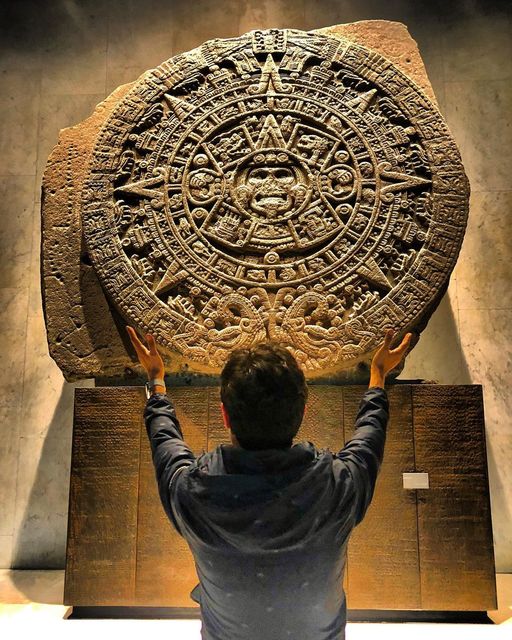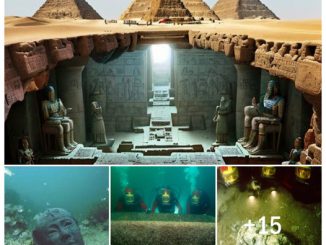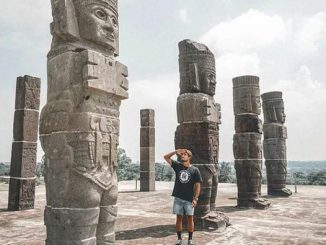In the heart of Mexico City, amidst the bustling Plaza Mayor, lies a silent sentinel of ancient wisdom and artistry – the Sun Stone. This awe-inspiring artifact, dating back to the reign of Moctezuma II in the early 16th century, is a testament to the rich cultural tapestry of the Aztec civilization. Discovered in 1790 at the southeastern edge of the Plaza Mayor, this monumental stone, though unfinished, stands as a towering symbol of the Aztec understanding of time, cosmology, and spirituality. Join me on a journey as we delve into the intricate details and profound significance of the Sun Stone, housed in the Museo Nacional de Antropología, and uncover the secrets it holds.

Unveiling the Symbolism: As we gaze upon the Sun Stone, we are immediately drawn to its mesmerizing array of intricate carvings and symbols. At its center lies the face of Tonatiuh, the Aztec sun god, with his tongue protruding, signifying the thirst for human blood necessary for the sun’s sustenance. Surrounding Tonatiuh are four squares representing previous eras or “suns” of creation, each dominated by its own elemental force – jaguar, wind, rain, and water. These elements, intricately intertwined with celestial bodies and mythological creatures, depict the cyclical nature of time and the cosmic balance revered by the Aztecs.
The Legacy of Moctezuma II: It was during the reign of Moctezuma II, the ninth emperor of the Aztec empire, that the Sun Stone was crafted. His rule, marked by both grandeur and tumult, witnessed the pinnacle of Aztec power as well as the looming shadows of Spanish conquest. Moctezuma II, often depicted in Aztec art and mythology, is believed to have been deeply intertwined with the cultural and religious significance embodied by the Sun Stone. Some interpretations suggest that the stone may have been intended as a monumental calendar, guiding the Aztec people through the cycles of time and ritualistic ceremonies.
Unfinished Masterpiece: Despite its grandeur and meticulous craftsmanship, the Sun Stone remains unfinished, leaving scholars and historians intrigued by its incomplete state. Speculations abound regarding the reasons behind its unfinished status – was it due to the abrupt end of Moctezuma II’s reign, the arrival of the Spanish conquistadors, or perhaps a deliberate choice by the artisans? The enigmatic nature of its completion, or lack thereof, adds another layer of mystery to an already captivating artifact, inviting us to ponder the untold stories and lost secrets of the Aztec civilization.
Ancient Discoveries and Modern Insights: The discovery of the Sun Stone in 1790 marked a pivotal moment in the study of Mesoamerican archaeology and anthropology. Since then, numerous other artifacts and relics have been unearthed, shedding light on the complex societies that once thrived in the region. From the majestic pyramids of Teotihuacan to the enigmatic glyphs of the Mayan civilization, each discovery offers a glimpse into the ingenuity, spirituality, and cultural richness of ancient Mesoamerica. As we marvel at these artifacts, we are reminded of the enduring legacy of these civilizations and the importance of preserving and understanding our shared human heritage.
Conclusion: The Sun Stone stands as a timeless testament to the ingenuity, spirituality, and artistic prowess of the Aztec civilization. Its intricate carvings and profound symbolism continue to captivate and inspire scholars, artists, and visitors alike, inviting us to embark on a journey through time and culture. As we unravel the mysteries of this ancient artifact, we are reminded of the enduring legacy of Mesoamerican civilizations and the importance of preserving and honoring our shared human heritage. So, the next time you find yourself in Mexico City, take a moment to visit the Museo Nacional de Antropología and behold the majestic beauty of the Sun Stone – a window into the soul of an ancient civilization.


